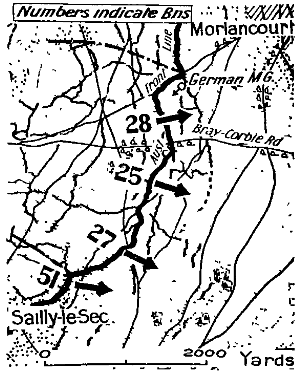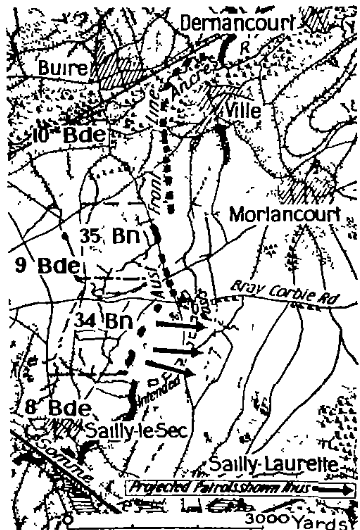|
Third Battle Of Morlancourt
The Third Battle of Morlancourt was fought on 10 June 1918, on the Western Front during World War I. The battle took place during the final stages of the German spring offensive, and saw troops from the Australian 2nd Division carry out a dusk assault on the Morlancourt spur, which provided observation of the village of Sailly-Laurette, to the south of Morlancourt. The main attack was carried out by the 7th Brigade, with flanking elements carrying out diversionary demonstrations. The assault proved successful for the Allies, with all objectives being secured, and a large number of prisoners being taken. Background Situated on the northern bank of the River Somme, Morlancourt is about north-east of Amiens, in the Somme department of northern France. The battle took place in the final stages of the German spring offensive, a large-scale offensive on the Western Front that had rapidly gained ground through the Somme after it had commenced on 21 March. With the vital rail junct ... [...More Info...] [...Related Items...] OR: [Wikipedia] [Google] [Baidu] |
Spur (topography)
A spur is a lateral ridge or tongue of land descending from a hill, mountain or main crest of a ridge. It can also be defined as another hill or mountain range which projects in a lateral direction from a main hill or mountain range. Examples of spurs include: *Abbott Spur, which separates the lower ends of Rutgers Glacier and Allison Glacier on the west side of the Royal Society Range in Victoria Land, Antarctica * Boott Spur, a subpeak of Mount Washington * Kaweah Peaks Ridge, a spur of the Great Western Divide, a sub-range of California's Sierra Nevada * Kelley Spur, east of Spear Spur on the south side of Dufek Massif in the Pensacola Mountains, Antarctica *Geneva Spur on Mount Everest * Sperrin Mountains in Northern Ireland Northern Ireland ( ga, Tuaisceart Éireann ; sco, label=Ulster Scots dialect, Ulster-Scots, Norlin Airlann) is a part of the United Kingdom, situated in the north-east of the island of Ireland, that is #Descriptions, variously described as . ... [...More Info...] [...Related Items...] OR: [Wikipedia] [Google] [Baidu] |
Third Battle Of The Aisne
The Third Battle of the Aisne (french: 3e Bataille de l'Aisne) was a battle of the German spring offensive during World War I that focused on capturing the Chemin des Dames Ridge before the American Expeditionary Forces arrived completely in France. It was one of a series of offensives, known as the ''Kaiserschlacht'', launched by the Germans in the spring and summer of 1918. Background The massive surprise attack (named ''Blücher-Yorck'' after two Prussian generals of the Napoleonic Wars) lasted from 27 May until 6 June 1918 and was the first full-scale German offensive following the Lys Offensive in Flanders in April. The Germans held the Chemin des Dames Ridge from the First Battle of the Aisne in September 1914 to 1917, when General Mangin captured it during the Second Battle of the Aisne (in the Nivelle Offensive). Operation Blücher-Yorck was planned primarily by General Erich Ludendorff, the First Quartermaster-General of the German Army, who was certain that su ... [...More Info...] [...Related Items...] OR: [Wikipedia] [Google] [Baidu] |
William Birdwood
Field Marshal William Riddell Birdwood, 1st Baron Birdwood, (13 September 1865 – 17 May 1951) was a British Army officer. He saw active service in the Second Boer War on the staff of Lord Kitchener. He saw action again in the First World War as Commander of the Australian and New Zealand Army Corps during the Gallipoli Campaign in 1915, leading the landings on the peninsula and then the evacuation later in the year, before becoming commander-in-chief of the Fifth Army on the Western Front during the closing stages of the war. He went on to be general officer commanding the Northern Army in India in 1920 and Commander-in-Chief, India, in 1925. Early life William Riddell Birdwood was born on 13 September 1865 in Kirkee, India. His father, Herbert Mills Birdwood, born in Bombay and educated in the UK, had returned to India in 1859 after passing the Indian Civil Service examination. In 1861, Herbert Birdwood married Edith Marion Sidonie, the eldest daughter of Surgeon-Major ... [...More Info...] [...Related Items...] OR: [Wikipedia] [Google] [Baidu] |
9th Brigade (Australia)
The 9th Brigade is a Reserve formation of the Australian Army headquartered at Keswick Barracks in Keswick, South Australia, with elements located in New South Wales and South Australia. The brigade was first raised in 1912 in New South Wales following the introduction of the compulsory training scheme. During World War I, the brigade was formed as part of the First Australian Imperial Force in 1916, with the majority of its recruits coming from New South Wales. It was assigned to the 3rd Division, and training was carried out in the United Kingdom before the brigade was committed to the fighting on the Western Front in November 1916. It fought in numerous battles in France and Belgium for the next two years. After the war, the brigade was disbanded, but was re-raised as a part-time formation in the Sydney area. During World War II, the brigade was mobilised for defensive duties, but did not see active service before it was disbanded in June 1944. In the post war period, the 9t ... [...More Info...] [...Related Items...] OR: [Wikipedia] [Google] [Baidu] |
Second Battle Of Morlancourt
The Second Battle of Morlancourt was fought over the period 4–14 May 1918, on the Western Front during World War I. The battle took place during the final stages of the German spring offensive. The battle began as a peaceful penetration action launched over several days by troops from the Australian 9th Brigade, to advance their lines around Morlancourt through a series of small raids against the opposing German 199th Division. Afterwards, both sides rotated their forces in the area and the Germans subsequently launched a counter-attack against the Australian 5th Brigade. This attack was eventually repulsed and the line held until June, when the Third Battle of Morlancourt took place around Morlancourt as the Australians secured the Morlancourt spur to consolidate their positions on the Somme before the Allied Hundred Days Offensive. Background Situated on the northern bank of the River Somme, Morlancourt is about north-east of Amiens, in the Somme department of norther ... [...More Info...] [...Related Items...] OR: [Wikipedia] [Google] [Baidu] |
18th Division (German Empire)
The 18th Division (''18. Division'') was a unit of the Prussian/German Army. It was formed on October 11, 1866, and was headquartered in Flensburg. The division was subordinated in peacetime to the IX Army Corps (''IX. Armeekorps''). The division was disbanded in 1919 during the demobilization of the German Army after World War I. The division was recruited primarily in Schleswig-Holstein. Combat chronicle In the Franco-Prussian War of 1870–71, the 18th Infantry Division saw action in the battles of Colombey and Gravelotte and in the Siege of Metz. After the Battle of Noiseville, the division entered the Loire campaign, fighting in the battles of 2nd Orléans, Beaugency-Cravant, and Le Mans. During the opening phases of World War I, the 18th Infantry Division participated in the Battle of Liège, the Allied Great Retreat, the First Battle of the Marne, and the First Battle of the Aisne. In 1916, it saw action in the Somme, and in 1917 it was involved in the Battles of ... [...More Info...] [...Related Items...] OR: [Wikipedia] [Google] [Baidu] |
3rd Division (Australia)
The 3rd Division was an infantry division of the Australian Army. Existing during various periods between 1916 and 1991, it is considered the "longest serving Australian Army division". It was first formed during World War I, as an infantry division of the Australian Imperial Force and saw service on the Western Front in France and Belgium. During this time it fought major battles at Messines, Broodseinde Ridge, Passchendaele, Amiens, and the St Quentin Canal. After the war the division was demobilised in 1919 before being re-raised in 1921 as part of the Citizen Forces, based in central Victoria. Throughout the 1920s and 1930s, the division's establishment fluctuated due to the effects of the Great Depression and a general apathy towards military matters. During World War II, the division was mobilised for war in December 1941 and initially undertook defensive duties in Australia before being deployed to New Guinea in 1943 where they took part in the Salamaua–Lae ca ... [...More Info...] [...Related Items...] OR: [Wikipedia] [Google] [Baidu] |
First Battle Of Morlancourt
The First Battle of Morlancourt was fought over the period 28–30 March 1918, on the Western Front during World War I. The battle saw troops from the Australian 3rd Division advance to fill a gap in the Allied line that had formed north of the River Somme during the German spring offensive. This advance towards Morlancourt was checked by German troops short of the Australian's objective of the spur overlooking Morlancourt and the Australians were subsequently counter-attacked by elements of the German 18th Division. These attacks were repulsed with heavy casualties, as Allied forces blunted the German advance towards Amiens, which subsequently stabilised the Allied line north of the Somme. The fighting then largely moved south; however, in the months following, two further actions – albeit minor – were fought around Morlancourt as the Australians sought to consolidate their positions around the village prior to the start of the Allied Hundred Days Offensive. Bac ... [...More Info...] [...Related Items...] OR: [Wikipedia] [Google] [Baidu] |
Australian Corps
The Australian Corps was a World War I army corps that contained all five Australian infantry divisions serving on the Western Front. It was the largest corps fielded by the British Empire in France. At its peak the Australian Corps numbered 109,881 men. By 1918 the headquarters consisted of more than 300 personnel of all ranks, including senior staff officers, as well as supporting personnel such as clerks, drivers and batmen. Formed on 1 November 1917, the corps replaced I Anzac Corps while II Anzac Corps, which contained the New Zealand Division, became the British XXII Corps on 31 December.Becke, p. 258. While its structure varied, Australian Corps usually included 4–5 infantry divisions, corps artillery and heavy artillery, a corps flying squadron and captive balloon sections, anti-aircraft batteries, corps engineers, corps mounted troops (light horse and cyclists), ordnance workshops, medical and dental units, transport, salvage and an employment company. History Fol ... [...More Info...] [...Related Items...] OR: [Wikipedia] [Google] [Baidu] |
Amiens
Amiens (English: or ; ; pcd, Anmien, or ) is a city and commune in northern France, located north of Paris and south-west of Lille. It is the capital of the Somme department in the region of Hauts-de-France. In 2021, the population of Amiens was 135,429. A central landmark of the city is Amiens Cathedral, the largest Gothic cathedral in France. Amiens also has one of the largest university hospitals in France, with a capacity of 1,200 beds. The author Jules Verne lived in Amiens from 1871 until his death in 1905, and served on the city council for 15 years. Incumbent French president Emmanuel Macron was born in Amiens. The town was fought over during both World Wars, suffering significant damage, and was repeatedly occupied by both sides. The 1918 Battle of Amiens was the opening phase of the Hundred Days Offensive which directly led to the Armistice with Germany. The Royal Air Force heavily bombed the town during the Second World War. In the aftermath, the city was ... [...More Info...] [...Related Items...] OR: [Wikipedia] [Google] [Baidu] |






